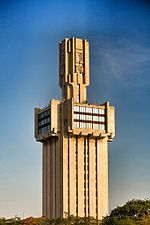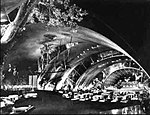The National Art Schools (Escuelas Nacionales de Arte) of Cuba is one of the most important educational institutions of the Cuban nation and has been declared as "National Monument".
Cuba's National Art Schools (Escuelas Nacionales de Arte, now known as the Instituto Superior de Arte) are considered by historians to be among the most outstanding architectural achievements of the Cuban Revolution.These innovative, organic Catalan-vaulted brick and terra-cotta structures were built on the site of a former country club in the far western Havana suburb of Cubanacán, which was once considered to be Havana's "Beverly Hills", and was then mainly reserved for Communist Party officials. The schools were conceived and founded by Fidel Castro and Che Guevara in 1961, and they reflect the utopian optimism and revolutionary exuberance of the early years of the Cuban Revolution. Over their years of active use, the schools served as the primary incubator for Cuba's artists, musicians, actors and dancers.
By 1965, however, the art schools and their architects fell out of favor as Soviet-inspired functionalist forms became standard in Cuba. Additionally, the schools were subjected to accusations that their design was incompatible with the Cuban Revolution. These factors resulted in the schools’ near-complete decommissioning and the departure of two of their three architects. Never fully completed, the complex of buildings lay in various stages of use and abandonment, some parts literally overgrown by the jungle until preservation efforts began in the first decade of the 21st century. The schools’ legacy was eventually brought to light by regional and international architectural journals in the 1980s, piquing the curiosity of observers both internationally and within Cuba through the 1990s. This growing interest reached its apex in 1999 with the publication of the book Revolution of Forms - Cuba's Forgotten Art Schools, by John Loomis, a California-based architect, professor, and author. Following the publication of Revolution of Forms, the schools attracted even greater international attention and in 2000 they were nominated for the World Monuments Fund Watch List. In November 2010, the National Art Schools were officially recognized as national monuments by the Cuban Government, and they are currently being considered for inclusion on the World Heritage list of sites which have "outstanding universal value" to the world.Cuba's National Art Schools have inspired a series of art installations under the name of Utopia Posible by the Cuban artist Felipe Dulzaides, the documentary film Unfinished Spaces by Alysa Nahmias and Ben Murray, and an opera directed by Robert Wilson entitled Revolution of Forms (named after John Loomis' book) written by Charles Koppleman.






